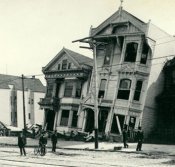
Worksheets and No Prep Teaching Resources
Reading Comprehension Worksheets
Earth Science

Earth Science
 Worksheets and No Prep Teaching Resources Reading Comprehension Worksheets Earth Science |
 Earth Science |
| edHelper's suggested reading level: | grades 8 to 9 | |
| Flesch-Kincaid grade level: | 8.37 |
|
Earthquakes and Our Society
By Trista L. Pollard |

|
 1 For anyone who has experienced an earthquake, the experience can be frightening and traumatic. In addition to the movement of the ground, people need to be concerned with collapsing buildings and falling debris, such as flying glass. The majority of the injuries and deaths that occur from earthquakes are due to falling objects and structures. The effects of an earthquake can also cause dangerous landslides, fires, gas line and electric explosions, and floodwaters from collapsing dams. The goal of seismologists is to understand why earthquakes and other seismic activity occur on Earth. This information, when shared with people in earthquake-prone areas, can help decrease the number of deaths and injuries that may occur.
1 For anyone who has experienced an earthquake, the experience can be frightening and traumatic. In addition to the movement of the ground, people need to be concerned with collapsing buildings and falling debris, such as flying glass. The majority of the injuries and deaths that occur from earthquakes are due to falling objects and structures. The effects of an earthquake can also cause dangerous landslides, fires, gas line and electric explosions, and floodwaters from collapsing dams. The goal of seismologists is to understand why earthquakes and other seismic activity occur on Earth. This information, when shared with people in earthquake-prone areas, can help decrease the number of deaths and injuries that may occur. |
Create Weekly Reading Books
Prepare for an entire week at once! |
| Leave your feedback on Earthquakes and Our Society (use this link if you found an error in the story) |
 |
Earth Science
|
 |
High School Reading Comprehensions and High School Reading Lessons
|